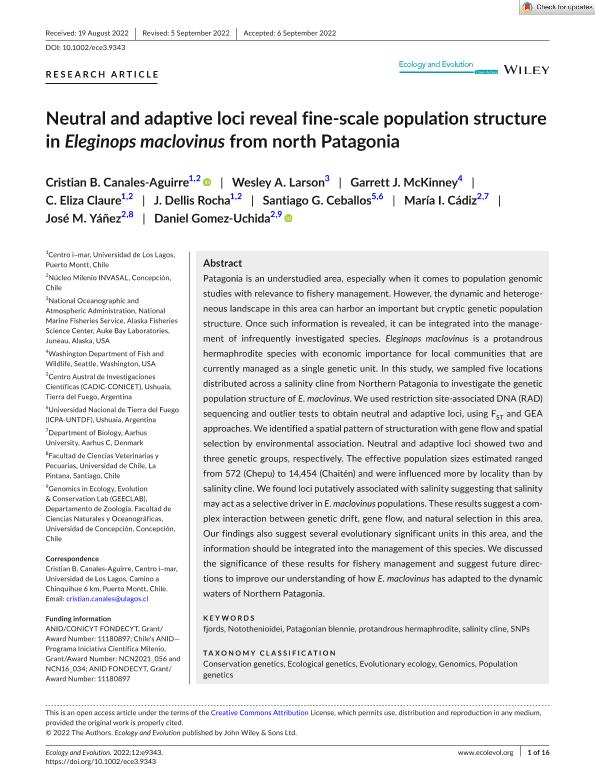Artículo
Neutral and adaptive loci reveal fine-scale population structure in Eleginops maclovinus from north Patagonia
Canales Aguirre, Cristian B.; Larson, Wesley A.; McKinney, Garrett J.; Eliza Claure, C.; Dellis Rocha, J.; Ceballos, Santiago Guillermo ; Cádiz, María I.; Yáñez, José M.; Gomez Uchida, Daniel
; Cádiz, María I.; Yáñez, José M.; Gomez Uchida, Daniel
 ; Cádiz, María I.; Yáñez, José M.; Gomez Uchida, Daniel
; Cádiz, María I.; Yáñez, José M.; Gomez Uchida, Daniel
Fecha de publicación:
10/2022
Editorial:
John Wiley & Sons
Revista:
Ecology and Evolution
ISSN:
2045-7758
Idioma:
Inglés
Tipo de recurso:
Artículo publicado
Clasificación temática:
Resumen
Patagonia is an understudied area, especially when it comes to population genomic studies with relevance to fishery management. However, the dynamic and heterogeneous landscape in this area can harbor an important but cryptic genetic population structure. Once such information is revealed, it can be integrated into the management of infrequently investigated species. Eleginops maclovinus is a protandrous hermaphrodite species with economic importance for local communities that are currently managed as a single genetic unit. In this study, we sampled five locations distributed across a salinity cline from Northern Patagonia to investigate the genetic population structure of E. maclovinus. We used restriction site-associated DNA (RAD) sequencing and outlier tests to obtain neutral and adaptive loci, using FST and GEA approaches. We identified a spatial pattern of structuration with gene flow and spatial selection by environmental association. Neutral and adaptive loci showed two and three genetic groups, respectively. The effective population sizes estimated ranged from 572 (Chepu) to 14,454 (Chaitén) and were influenced more by locality than by salinity cline. We found loci putatively associated with salinity suggesting that salinity may act as a selective driver in E. maclovinus populations. These results suggest a complex interaction between genetic drift, gene flow, and natural selection in this area. Our findings also suggest several evolutionary significant units in this area, and the information should be integrated into the management of this species. We discussed the significance of these results for fishery management and suggest future directions to improve our understanding of how E. maclovinus has adapted to the dynamic waters of Northern Patagonia.
Archivos asociados
Licencia
Identificadores
Colecciones
Articulos(CADIC)
Articulos de CENTRO AUSTRAL DE INVESTIGACIONES CIENTIFICAS
Articulos de CENTRO AUSTRAL DE INVESTIGACIONES CIENTIFICAS
Citación
Canales Aguirre, Cristian B.; Larson, Wesley A.; McKinney, Garrett J.; Eliza Claure, C.; Dellis Rocha, J.; et al.; Neutral and adaptive loci reveal fine-scale population structure in Eleginops maclovinus from north Patagonia; John Wiley & Sons; Ecology and Evolution; 12; 10; 10-2022; 1-16
Compartir
Altmétricas



